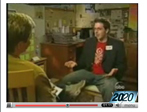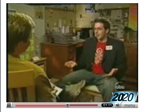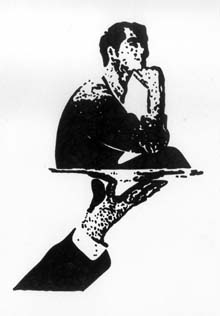 PICTURE THIS: you walk into Borders on a Sunday afternoon. You head over to the business section to pick up the latest book on leadership.
PICTURE THIS: you walk into Borders on a Sunday afternoon. You head over to the business section to pick up the latest book on leadership.
Flipping through, you see nothing remarkable … yet.
So you keep flipping. And flipping. And flipping. Frustratingly hoping to come across a poignant sentence, a cool graph or an astonishing picture to use in tomorrow’s staff meeting.
But to no avail.
About seven minutes go by. You reach the appendix of the book, having found nothing that stood out.
Well, back to the shelf this goes! You think.
And then.
Then something else catches your eye.
“Hmm. What’s this…?” you say.
You grab a different book. You lean up against the shelf and randomly open it to page 147.
And within three seconds, you’re smiling. Nodding and affirming and pointing out a piece of leadership advice that’s SO relevant (and SO SIMPLE), you say to yourself, “Wow. That’s goooood! I’m buying this book for my boss!”
So you do.
And it only took … what? A few seconds?
LESSON LEARNED: the longer they take, the less they buy.
In Doug Hall’s (amazing) Jumpstart Your Brain, he shares several brilliant observations on this very topic.
Based on his extensive research with Proctor & Gamble’s retail division, Doug learned three things:
1. Complexity generates contemplation. You lose when your customer has to contemplate your idea. In the process of contemplating, customers start looking at other options.
2. Get them early. If it takes more than ten seconds to explain or grasp, it’s probably not a wicked good idea.
3. Simple ideas are self-evident. And self-evident products make you want to pick them up when you see the name and the front of the package. No additional communication required.
It’s kind of like the end of Jerry Maguire.
Tom Cruise barges into Rene Zelwegger’s house to profess his love for her. He rambles on and on about how she “completes” him. Everyone in the audience is sobbing.
Eventually, she interrupts his monologue and says, “You had me at hello.”
You had me at hello.
That’s exactly what you need to do.
You need to have them at hello.
Because if you don’t, every second that passes decreases the probability of a sale.
The sale of…
Your idea.
Your self.
Your service.
Your product.
LESSON LEARNED: if you don’t have them at hello, it’s already too late.
Because the longer they take, the less they buy.
HERE’S HOW I KNOW THIS: I’ve been wearing a nametag 24-7 for the past 2,431 days.
I do it to make people friendlier. That’s it!
And I’ve probably explained this idea to well over 100,000 people.
Now, according to seven years of non-scientific, empirical data, approximately 10% of the people I encounter will think I’m out of my damn mind.
(Which is true.)
But these people just don’t (and won’t) get it.
They require me to cite scientific data.
They ask me to explain my philosophy over and over.
They argue relentlessly about the validitiy of wearing a nametag.
(And all the while I’m thinking: dude, it’s not that complicated. Nametags = friendlier people)
Which makes me realize something: these people will NEVER, at any point, accept, like or embrace my idea.
Because I never had them at hello.
See, first impressions are based on instinct and emotion. And because they tend to be correct, the first impressions people form about you will probably stay in their minds forever.
After all, people put pressure on themselves to behave consistently with their own existing commitments.
This is known as the primacy effect. Meaning, the information people see or learn about you is more powerful than what is learned later.
IN SHORT: if it takes too long for someone to “get” you (or your idea or your product), they’re probably not going to buy into it. Ever.
The longer they take, the less they buy.
Also, here’s something else I’ve noticed after 2,430 days:
90% of the people I encounter, only SECONDS after hearing that I choose to wear a nametag all the time, will say to me, “That’s the coolest idea I’ve ever heard!”
And they not only embrace the idea, but usually tell at least 10 people about it.
Because I had them at hello.
And it took … what? Three seconds?
Right. Because if the longer they take, the less they buy; then the SHORTER they take, they MORE they buy!
OK. So, here’s what this means for you:
1. KEEP it simple. Say ONE thing. Assure that your ideas; products, services and marketing materials are self-evident. That they need no further communication. That people “get” your stuff right away.
2. MAKE it easy. Ever read a business book without boldface, underlines, italics, font changes or pictures? It’s a pain in the butt! See, few authors understand the value of architecture in writing. So, even if you don’t write books, remember: make it easy. Punch people in the face with what they need to see, hear and know about your business right away.
3. TOUCH it up. If you find that it’s taking too long to convince people, don’t worry! This is your opportunity to tweak your idea, sales pitch or product. Brainstorm several approaches and practice them on friends. If you “get them at hello,” you’re on the right track. Super easy litmus test.
Ultimately, what we’re talking about is a first impression.
Of you.
Of your ideas.
Of your business.
SO REMEMBER: complexity generates contemplation; and contemplation kills sales.
Get them at hello.
Because they longer they take, the less they buy.
LET ME ASK YA THIS…
Do you have people at hello?
LET ME SUGGEST THIS…
Share an example of someone who had YOU at hello with THEIR business idea.
* * * *
Scott Ginsberg
That Guy with the Nametag
www.hellomynameisscott.com
 Are you the luckiest person you know?
Are you the luckiest person you know?
Watch Scott’s interview on 20/20!

 “Hey Scott, how do you get 35,000 hits a day on your website?” I’m often asked.
“Hey Scott, how do you get 35,000 hits a day on your website?” I’m often asked. Are you the luckiest person you know?
Are you the luckiest person you know? The origin of the term “thought leader” goes back a few years.
The origin of the term “thought leader” goes back a few years. Are you the luckiest person you know?
Are you the luckiest person you know? According to
According to  * * * *
* * * * Where do you get your best ideas?
Where do you get your best ideas? * * * *
* * * * Everyone loves kids.
Everyone loves kids. * * * *
* * * * There are 55 strategies in my
There are 55 strategies in my  * * * *
* * * * Talking makes you think.
Talking makes you think. * * * *
* * * * So, you want to build a brand, huh?
So, you want to build a brand, huh? * * * *
* * * * 1. Eliminate the following sentences from your vocabulary:
1. Eliminate the following sentences from your vocabulary: * * * *
* * * *